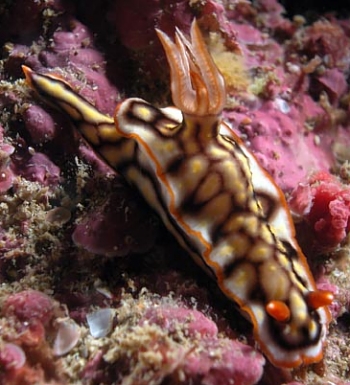
Hypselodoris jacksoni
Wilson & Willan, 2007
Order: NUDIBRANCHIA
Suborder: DORIDINA
Superfamily: EUDORIDOIDEA
Family: Chromodorididae
DISTRIBUTION
Coral Sea [SW Pacific - eastern Australia from nthn New South Wales to sthn Queensland, Lord Howe Island, Norfolk Island]
PHOTO
Locality: "The Trench", Mooloolaba,, 18 metres, Queensland, Australia., Pacific Ocean, 11 Februrary 2006, rocky reef. Length: 33 mm. Photographer: David Mullins.
Hypselodoris jacksoni has a relatively high body profile, an elongate body, and a narrow mantle skirt. The gill pocket forms a high raised collar as in H. krakatoa.
The background colour of the mantle and the foot is translucent greyish often covered in part by opaque white. There is an open reticulation of relatively thin dark brown to black lines arranged in a symmetrical pattern down the mantle. There is usually an irregularly shaped and slightly raised milky yellow patch in each of the spaced formed by the reticulation. A similar colour pattern is found on the sides of the body/ foot. There is a thin orange band around the mantle edge but this absent on the edge of the foot except at the posterior end.
The gills are held erect. They are triangular in cross section, translucent, with an orange line up each edge. The rhinophores are an intense orange with a pale whitish tip.
-
Wilson, N.G. & Willan, R.C. (2007) Hypselodoris jacksoni, a new species from the south-western Pacific Ocean (Nudibranchia: Chromodorididae), with a discussion on intraspecific variation in mantle glands in Chromodoris willani Rudman, 1982. Zootaxa, 1549: 29-42
Rudman, W.B., 2007 (August 28) Hypselodoris jacksoni Wilson & Willan, 2007. [In] Sea Slug Forum. Australian Museum, Sydney. Available from http://www.seaslugforum.net/find/hypsjack
Related messages
Re: Hypselodoris jacksoni feeding [2]
September 1, 2007
From: Bruce Wilkie
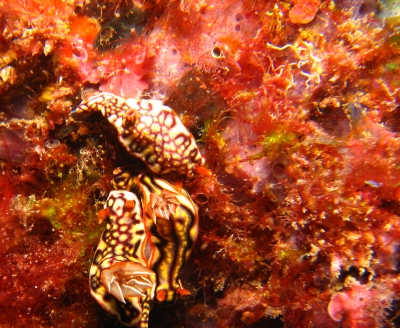
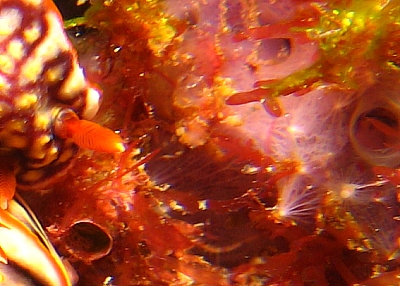
Concerning message #20611:
Hi Bill,
I have been looking through my files on Hypselodoris jacksoni for feeding records. Here is the second lot. I hope they help.
Locality: Flat rock, Point lookout, Nth Stradbroke Island, Queensland, Australia. Upper photos: 29th January 2007, Depth 12mts. Lower photo: 30th December 2006, Depth 12 mts. Photographer: Bruce Wilkie.
Many thanks,
Bruce Wilkie.
brucedwilkie@yahoo.com.au
Wilkie, B., 2007 (Sep 1) Re: Hypselodoris jacksoni feeding [2]. [Message in] Sea Slug Forum. Australian Museum, Sydney. Available from http://www.seaslugforum.net/find/20612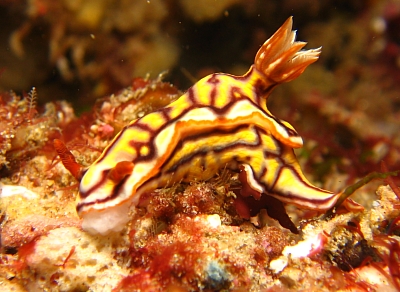
Thanks Bruce,
The sponge in the upper photos is Euryspongia. The way the colony is almost totally covered in overgrowing plants seems to be a fairly usual occurrence for this species.
In the lower photo the buccal bulb is partially everted but I am unable to identify the sponge material in the lower photo.
Best wishes,
Bill Rudman
Hypselodoris jacksoni feeding [1]
September 1, 2007
From: Bruce Wilkie
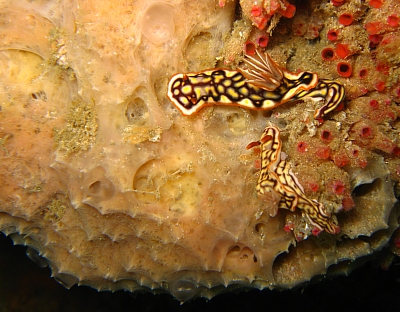
Concerning message #18769:
Hi Bill,
I have been looking through my files on Hypselodoris jacksoni for feeding records. In most photo's the animals are with their heads down feeding but the sponge is not visible. Here is one with a visible sponge. I hope they help.
Locality: Flat rock, Point Lookout, Nth Stradbroke island, 14 mts, Queensland, Australia. , Pacific Ocean., 4 December 2005, Rocky reef, hard and soft corals, sponges. Photographer: Bruce Wilkie.
Many thanks,
Bruce Wilkie.
brucedwilkie@yahoo.com.au
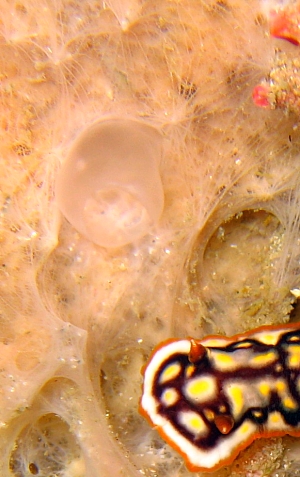
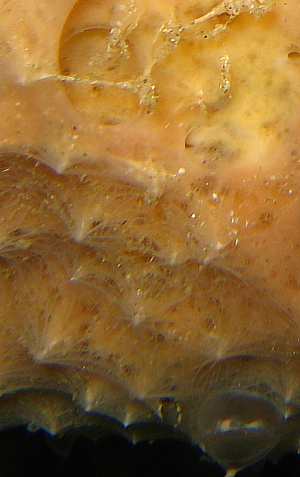
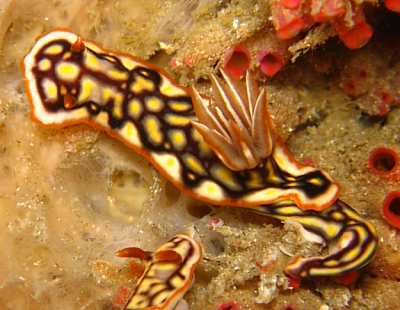
Thanks Bruce,
It is unusual to see such a large colony of Euryspongia so free of overgrowths. The photos in your second message [#20612] with the colony almost totally hidden are what we have come to expect. I have included a couple of close-ups to show the arrangement of the spongin fibres
Best wishes,
Bill Rudman
Hypselodoris jacksoni from nthn New South Wales
August 31, 2007
From: Leanne & David Atkinson
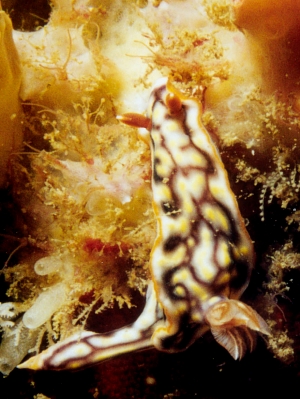
Dear Bill,
Here are some pictures of the newly described Hypselodoris jacksoni from the Solitary Islands in northern New South Wales. Nerida Wilson identified them for us previously. We found them under a ledge in a shallow surgey place called the E Gutters. The pictures aren't brilliantly clear because we weren't game to get in too close with the surge pushing us and the camera uncontrollably towards the roof of the ledge. They were quite close to some Hypselodoris bennetti and the many named Ceratosoma flavicostatum.
Locality: Photographed at E. Gutters, NorthWest Solitary Island, 10 metres, Northern New South Wales, Australia, Pacific, October 2000, Rocky reef with sponges, ascidians and corals. Length: approximately 30 mm. Photographer: Leanne & David Atkinson.
Hope the photos are of interest in showing their range.
Thanks for all your work on the forum,
Leanne & David Atkinson
atk@hunterlink.net.au
Atkinson, L. & D., 2007 (Aug 31) Hypselodoris jacksoni from nthn New South Wales. [Message in] Sea Slug Forum. Australian Museum, Sydney. Available from http://www.seaslugforum.net/find/20588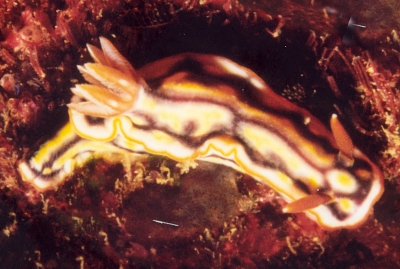
Dear Leanne & David,
Thanks for the record. Looking closely at your upper photo I am pretty sure it is feeding on a pale version of it sponge food, Euryspongia sp. You can see a purplish patch just to the left of the animal. However it is a bit tenuous to actually record as a feeding record
Best wishes,
Bill Rudman
Hypselodoris jacksoni from North Stradbroke Island, Queensland
August 29, 2007
From: Bruce Wilkie
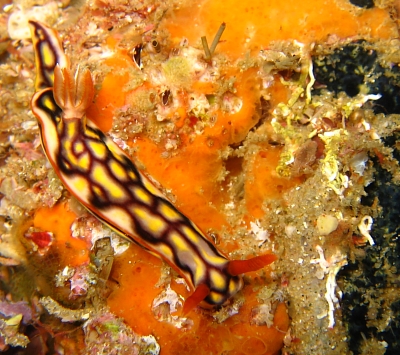
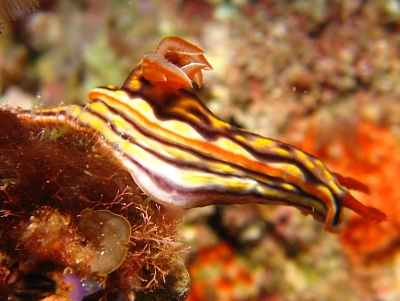
Concerning message #18378:
Hi Bill,
I find these animals on a fairly regular basis.
The closest I have come to id-ing them is on another web-site which has them listed as Hypselodoris sp.1. Can`t seem to find anything on the forum to cross match them with. Any help would be appreciated.
Locality: Upper photo: Flat Rock North Stradbroke Island, 10-14 metres, Queensland Australia, Pacific ocean, 05 November 2006, rocky reef with sponges, hard & soft corals . Length: 25mm. Middle photo: 18 November 2006, Flat Rock, NSI, Depth 10 mts. Lower photo: 25 November 2006, Manta Bommie, NSI, Depth 8 mts. Photographer: Bruce Wilkie.
Many Thanks,
Bruce Wilkie.
brucedwilkie@yahoo.com.au
Wilkie, B., 2007 (Aug 29) Hypselodoris jacksoni from North Stradbroke Island, Queensland. [Message in] Sea Slug Forum. Australian Museum, Sydney. Available from http://www.seaslugforum.net/find/18769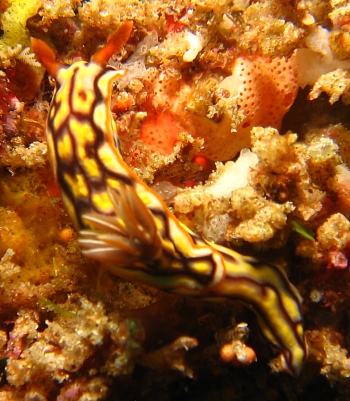
Dear Bruce,
I just remembered I put your message aside some time ago because I was expecting the description of Hypselodoris jacksoni to be published anyday. As you can see from today's other messages [#20572, #20575], it finally has a name.
Best wishes,
Bill Rudman
Hypselodoris jacksoni more pics
August 29, 2007
From: David Mullins
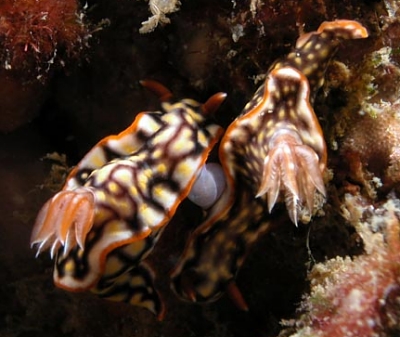
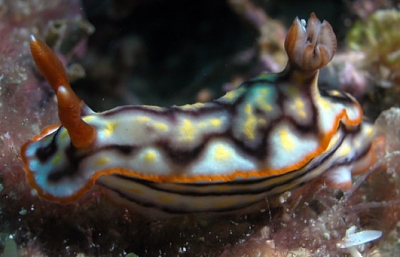
Dear Bill,
Here are some more photos of Hypselodoris jacksoni (to complement message #20572 ) filling out the "doing things" aspect of this species by illustrating mating and egg laying.
Upper Photo: "The Pinnacles", Gneering Shoals, Mooloolaba, 22 metres, Queensland, Australia, Pacific Ocean, 25 March 2005, rocky reef. Length: ~30 mm. Middle Photo: Old Woman Island, Maroochydore, Queensland, Australia, Pacific Ocean. Depth: 10 metres, Length: 35 mm, 11 August 2007. Lower Photo: Old Woman Island, Maroochydore, Queensland, Australia, Pacific Ocean. Depth: 8 metres, Length: ~35 mm , 30 December 2005, Photos: David Mullins.
Regards,
David Mullins.
david@nudibranch.com.au
Mullins,D.A., 2007 (Aug 29) Hypselodoris jacksoni more pics. [Message in] Sea Slug Forum. Australian Museum, Sydney. Available from http://www.seaslugforum.net/find/20575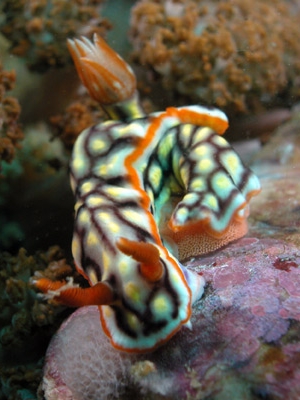
Thanks again David,
Bill Rudman
Hypselodoris jacksoni from sthn Queensland
August 29, 2007
From: David Mullins
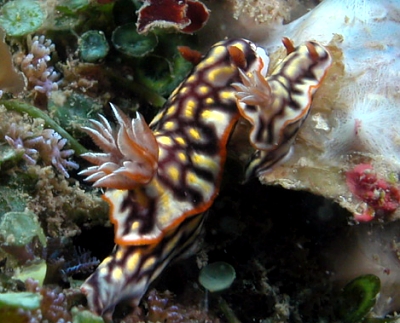
Dear Bill,
I thought you & the forum readers might be interested in a record from southern Queensland, Australia of the newly described species Hypselodoris jacksoni Wilson & Willan, 2007.
This species is very common here on the Gneering Shoals and around Old Woman Island (Mudjimba Island) on the Sunshine Coast, Queensland. We see it on just about every dive and we dive every weekend. I have included photos of feeding and the upper photo the oral tube can just be observed on the right side of the left specimen and the feeding track on the siliceous sponge is also evident. Additionally the lower image shows an aggregation that might be feeding (the nearest thing to a nudibranch "feeding frenzy" perhaps).
Upper Photo: Locality: Old Woman Island, Maroochydore, Queensland, Australia, Pacific Ocean. Depth: 10 metres, Length: 32 mm & 20 mm,
30 December 2006. Lower Photo: "Castle Rock", Gneering Shoals, Mooloolaba, Queensland, Australia, Pacific Ocean. Depth: 18 metres, Length: 20 mm, 01 August 2004, Photographer: David Mullins. [middle photos are close-ups from other two]
I have more images following in a 2nd message [#20575 ].
Regards,
David Mullins
(long time reader 1st time sender)
david@nudibranch.com.au
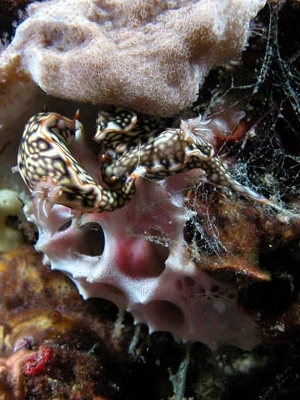
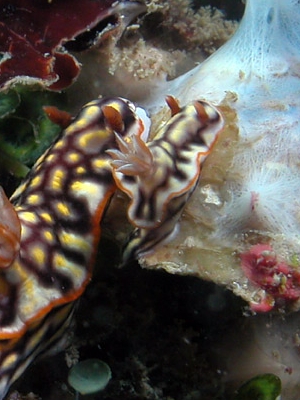
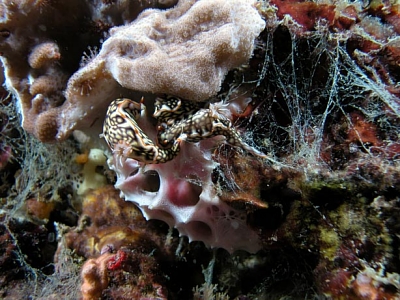
Dear David,
It may be your first message, but I hope it's not your last. It's not often we get all this biological information so quickly for a species only a few days old.
The white network in the sponge in the upper photo is not, as you thought, made of siliceous spicules, but is the very characteristic network of spongin fibres found in the dysideid genus Euryspongia. Species of Hypselodoris, and other chromodorids, feed on sponges which lack skeletal spicules. Your observations are very interesting because quite a few of the 'high profiled' species of Hypselodoris feed on Euryspongia. The spiderweb-like tangle of fibres all over your lower photo are part of the sponge colony's remains, showing just how much of the colony these nudibranchs have consumed.
This is a valuable contribution to our knowledge.
Best wishes,
Bill Rudman
